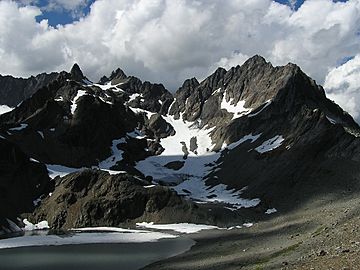Mount Anderson (Washington) facts for kids
Quick facts for kids Mount Anderson |
|
|---|---|

Mount Anderson
|
|
| Highest point | |
| Elevation | 7,330 ft (2,234 m) |
| Prominence | 721 ft (220 m) |
| Naming | |
| Etymology | Thomas M. Anderson |
| Geography | |
| Parent range | Olympic Mountains |
| Topo map | USGS Mount Steel |
Mount Anderson is a tall mountain, about 7,330 feet (2,234 meters) high. It's found in the Olympic Mountains in the Pacific Northwest region of the United States. This impressive peak stands right in the middle of Olympic National Park in Washington state. It is the second highest point on the Anderson Massif, which is a large group of mountains, with West Peak being the highest.
Mount Anderson once had a large ice formation called Anderson Glacier on its southern side. Another glacier, called Eel Glacier, is located in a bowl-shaped valley (a cirque) northwest of the top. The Hanging Glacier can be found on the eastern side of a ridge that stretches north from the peak.
This mountain is very important for water. It sits at the center of three main watersheds in the Olympic Range. A watershed is an area of land where all the water drains into a single river or body of water. Most of the water from Mount Anderson flows into the Dosewallips River. This river then empties into the Hood Canal and finally into Puget Sound. Water from the western side of the mountain flows into the Quinault River and eventually reaches the Pacific Ocean. Some water from the northwest side goes into the Hayes River, which flows north to the Strait of Juan de Fuca.
Mount Anderson was named by an army officer, Lieutenant Joseph O'Neil. He named it after his commanding officer, Thomas M. Anderson. The first time people successfully climbed Mount Anderson was in 1920. A group of 13 climbers, led by Fairman B. Lee, made the first ascent.
Understanding Mount Anderson's Climate
Mount Anderson is located in a special type of weather area called the marine west coast climate zone. This means it gets a lot of rain and snow, especially in winter. Most of the weather systems that bring rain start over the Pacific Ocean. They then travel northeast towards the Olympic Mountains.
When these weather systems hit the tall Olympic peaks, the air is forced to rise. As the air goes higher, it cools down and drops its moisture as rain or snow. This process is called orographic lift. Because of this, the Olympic Mountains get a lot of precipitation. During winter, it's usually cloudy, but in summer, high-pressure systems over the Pacific Ocean often bring clear skies.
Exploring Mount Anderson's Geology
The Olympic Mountains, including Mount Anderson, are made up of interesting rocks. These rocks were formed from pieces of old ocean floor and sediments. Imagine the Earth's plates slowly moving and crashing together. When this happened, parts of the ocean floor were pushed up and over other land, forming these mountains.
The rocks are mostly sandstone, a type of rock made from sand, and turbidite, which are layers of sediment deposited by underwater currents. There's also basaltic oceanic crust, which is rock from the ocean floor. These rocks were formed during the Eocene period, which was about 56 to 34 million years ago.
The mountains got their current shape during the Pleistocene era, also known as the Ice Age. This was a time when huge sheets of ice, called glaciers, covered much of the Earth. These glaciers moved and carved out the valleys and peaks we see today. They advanced and retreated many times, shaping the landscape through erosion.



